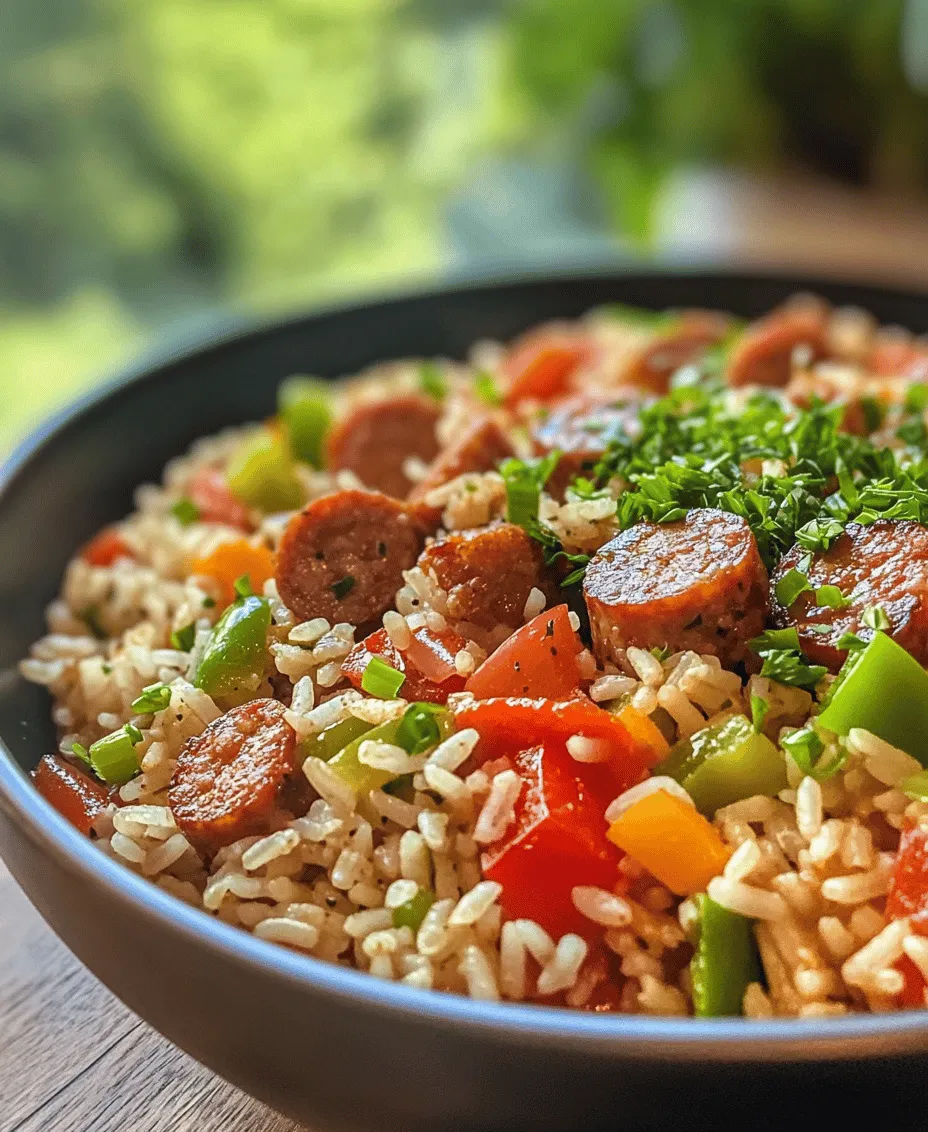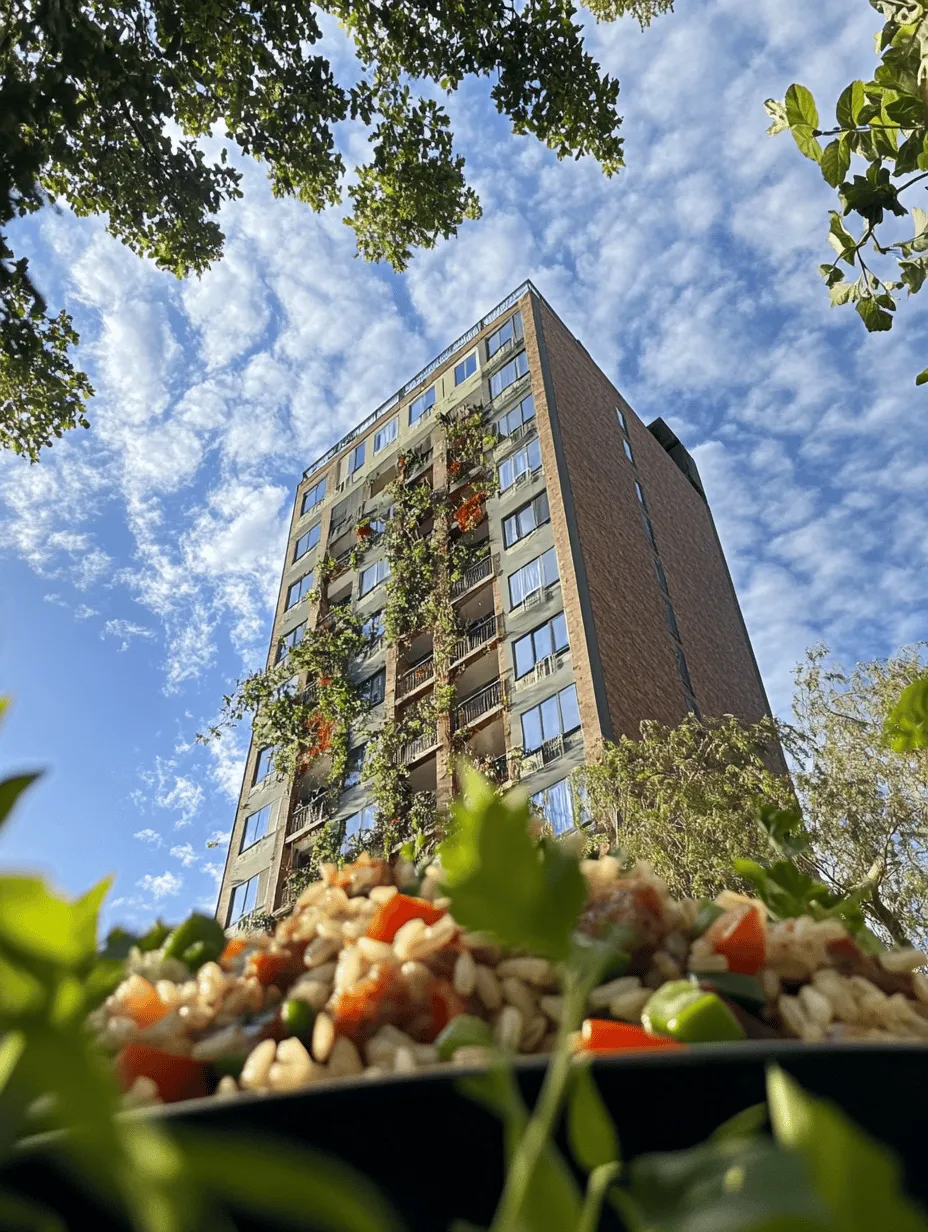Introduction to Cajun Cuisine
Cajun cuisine, with its vibrant flavors and hearty ingredients, is a culinary tradition that has its roots in the rich culture of Louisiana. Originating from the Acadian exiles who settled in this region, Cajun cooking is characterized by its use of local ingredients, bold seasonings, and a deep connection to the land and community. The essence of Cajun food lies in its ability to bring families and friends together around a table, sharing stories and laughter over dishes that are as full of character as the people who create them.
One standout dish that embodies the spirit of Cajun cuisine is the Quick Cajun Sausage and Rice Skillet. This one-pan meal is not only a celebration of robust flavors but also a practical solution for busy weeknights. With a preparation time of just 30 minutes, this recipe combines the smoky richness of sausage, the heartiness of rice, and a medley of vibrant vegetables, all brought together by the signature spices that define Cajun cooking. Whether you’re a seasoned home cook or a beginner, this dish promises a satisfying and delicious experience that will transport your taste buds straight to the bayou.
In this article, we will explore the essential ingredients that make this dish so appealing, followed by step-by-step instructions to help you create a mouthwatering Cajun Sausage and Rice Skillet in your own kitchen.
Understanding the Ingredients
To master the Quick Cajun Sausage and Rice Skillet, it’s essential to understand the key ingredients that contribute to its unique flavor and texture. Let’s break down these components:
Smoked Sausage Options: Andouille vs. Kielbasa
The heart of this dish lies in the choice of sausage, and two popular options are andouille and kielbasa. Andouille sausage is a staple in Cajun cooking, renowned for its smoky flavor and spice. Typically made from pork, it is seasoned with garlic, pepper, and other spices, offering a robust taste that meshes beautifully with the other ingredients. On the other hand, kielbasa, a Polish sausage, is milder and slightly sweeter, making it a versatile alternative for those who prefer a less intense flavor.
When selecting your sausage, consider the overall flavor profile you wish to achieve. For a classic Cajun experience, andouille is the way to go, while kielbasa can provide a gentler taste that still complements the dish well.
The Role of Rice in Cajun Dishes
Rice is a fundamental component of many Cajun dishes, acting as the base that absorbs and enhances the flavors of the ingredients surrounding it. In this recipe, medium-grain white rice is commonly used due to its ability to cook evenly and soak up the savory broth. The starches in the rice also help to create a creamy texture as it cooks with the other elements, resulting in a hearty and satisfying meal.
Importance of Vegetables: Onions and Bell Peppers
Cajun cooking is not just about the meat; it also celebrates the vibrant colors and flavors of fresh vegetables. In this recipe, onions and bell peppers play a crucial role in building the dish’s flavor base. Onions add a natural sweetness and depth, while bell peppers introduce a crisp texture and a mild peppery flavor.
Bell peppers, available in various colors like green, red, and yellow, not only enhance the dish visually but also contribute essential vitamins and antioxidants. Choosing a mix of colors will not only brighten your skillet but also provide a range of nutrients.
The Flavor Profile of Cajun Seasoning and Smoked Paprika
Cajun seasoning is a blend of spices that delivers a signature kick to any dish. Typically composed of paprika, cayenne pepper, garlic powder, onion powder, and various herbs, this seasoning encapsulates the essence of Cajun cuisine. The heat from the cayenne pepper is balanced by the sweetness of the paprika, creating a harmonious blend that elevates the overall flavor of the dish.
Smoked paprika, specifically, adds an additional layer of complexity with its rich, smoky undertones. This ingredient enhances the dish’s savory profile, making every bite a burst of flavor.
Nutritional Insights and Benefits of the Ingredients Used
The Quick Cajun Sausage and Rice Skillet is not only delicious but also packed with nutritional benefits. The combination of protein from the sausage, carbohydrates from the rice, and vitamins from the vegetables creates a well-rounded meal.
– Protein: The smoked sausage provides a hearty source of protein, essential for muscle growth and repair.
– Carbohydrates: Rice serves as a great source of energy, making it a staple in many diets.
– Vitamins and Minerals: Bell peppers and onions are rich in vitamins A, C, and various B vitamins, as well as antioxidants that support overall health.
When prepared with care, this dish can be a nutritious meal option that satisfies hunger while providing essential nutrients.
Step-by-Step Cooking Instructions
Now that we have a solid understanding of the ingredients, it’s time to dive into the cooking process. This Quick Cajun Sausage and Rice Skillet is designed to be straightforward and efficient, making it perfect for busy weeknights. Let’s break down the steps to ensure you achieve the best results.
Preparing the Skillet: Techniques for Sautéing Sausage
Start by gathering your ingredients and a large skillet. A heavy-bottomed skillet is preferred for this recipe as it distributes heat evenly and prevents sticking.
1. Heat the Skillet: Begin by placing the skillet over medium heat. Allow it to warm up for a couple of minutes.
2. Add Oil: Drizzle in a tablespoon of olive oil or vegetable oil. This will help prevent the sausage from sticking and allow it to brown beautifully.
3. Sauté the Sausage: Slice your chosen sausage (andouille or kielbasa) into bite-sized pieces. Once the oil is shimmering, add the sausage to the skillet.
4. Browning for Flavor Development: Allow the sausage to cook undisturbed for a few minutes until it develops a nice brown crust. This browning process, known as the Maillard reaction, is crucial as it enhances the flavor profile of the sausage and, ultimately, the dish.
Sautéing the Vegetables: Achieving the Perfect Texture and Aroma
Once the sausage is browned, it’s time to incorporate the vegetables.
1. Add Onions and Bell Peppers: Dice one medium onion and chop two bell peppers (you can use a mix of colors for visual appeal). Add them to the skillet with the sausage.
2. Cook Until Tender: Sauté the mixture for about 5-7 minutes, stirring occasionally, until the vegetables have softened and the onions become translucent. This step is vital for developing the dish’s overall flavor.
3. Enhance with Garlic: Mince three cloves of garlic and add them to the skillet. Garlic adds an aromatic quality that complements the other ingredients. Sauté for an additional minute until fragrant, being careful not to burn it.
Combining and Cooking the Ingredients: Creating the Base
Now that your sausage and vegetables are perfectly sautéed, it’s time to bring everything together.
1. Rinse the Rice: Measure out one cup of medium-grain white rice. Rinsing the rice under cold water is essential to remove excess starch, which can make the dish gummy. Rinse until the water runs clear, then drain.
2. Add the Rice to the Skillet: Stir the rinsed rice into the sausage and vegetable mixture, ensuring that it’s evenly distributed.
3. Pour in the Broth: Add two cups of low-sodium chicken broth to the skillet. Using low-sodium broth allows you to control the dish’s saltiness while still imparting rich flavor.
4. Seasoning: Sprinkle in two tablespoons of Cajun seasoning and a teaspoon of smoked paprika. Stir well to combine all ingredients, allowing the flavors to meld.
Balancing Flavors with Cajun Seasoning and Spices
As the dish comes together, it’s important to balance the flavors.
1. Bring to a Simmer: Increase the heat to high and bring the mixture to a gentle boil. Once boiling, reduce the heat to low, cover, and let it simmer for about 20 minutes. This allows the rice to absorb the flavors and cook through.
2. Check for Doneness: After 20 minutes, check the rice for doneness. If it’s tender and has absorbed the liquid, your dish is ready. If there is still some liquid remaining, cover and let it cook for a few more minutes.
With these steps, you are well on your way to creating a delicious Quick Cajun Sausage and Rice Skillet that is perfect for any occasion. The combination of smoky sausage, tender rice, and flavorful vegetables is sure to please your palate and satisfy your hunger. Stay tuned for additional tips and variations to take this dish to the next level!

Finalizing the Dish: Ensuring Perfect Rice Texture
Achieving the perfect rice texture is crucial for your Quick Cajun Sausage and Rice Skillet. To ensure the rice is fluffy and cooked properly, follow these final steps once the cooking time has elapsed. After the rice has absorbed the liquid, remove the skillet from heat, and let it sit covered for an additional 5-10 minutes. This resting time allows the steam to finish cooking the rice and helps any remaining moisture to be absorbed, resulting in a tender texture.
Techniques for Checking Rice Doneness
To check if your rice is done, you can use a fork to fluff it gently. The rice should be tender but not mushy, with each grain separated. If you find the rice is still too firm or hard, add a couple of tablespoons of water, cover the skillet again, and return it to low heat for a few more minutes. Continue this process until the rice reaches your desired doneness.
Incorporating Sausage and Corn for Added Flavor and Nutrition
Once the rice is perfectly cooked, it’s time to fold in the cooked sausage and corn. This step is essential for ensuring that the sausage flavors blend beautifully with the rice. If you’ve cooked the sausage separately, slice it into bite-sized pieces and add it to the skillet. For the corn, you can use fresh, frozen, or canned corn—whichever you have on hand. Stir everything together gently, allowing the heat from the skillet to warm the sausage and corn through, which will enhance their flavors while ensuring every bite is packed with deliciousness.
Flavor Variations and Customizations
One of the best aspects of the Quick Cajun Sausage and Rice Skillet is its versatility. Here are some suggestions for customizing the dish to suit your taste preferences.
Suggestions for Ingredient Substitutions
If you’re looking to modify the recipe based on what you have in your pantry, consider substituting the sausage with other proteins like chicken, shrimp, or even tofu. Each of these options will bring a different flavor profile to the dish while maintaining that Cajun essence.
Vegetarian Alternatives: Plant-Based Sausage or Beans
For those who prefer a vegetarian option, using plant-based sausage is a great alternative. Alternatively, you can use canned beans such as black beans or kidney beans, which not only add protein but also a hearty texture.
Seasonal Vegetable Variations: Using Zucchini or Carrots
Adapting to the seasons can also enhance your skillet dinner. Adding vegetables such as zucchini, diced bell peppers, or shredded carrots can introduce new flavors and textures while boosting the nutritional value of the dish. Simply sauté these veggies along with the onions and garlic for a colorful and nutritious addition.
Adjusting Spice Levels: Catering to Different Palates
Cajun cuisine is known for its bold flavors, but you can easily adjust the spice levels to cater to different palates. If you prefer a milder dish, reduce the amount of Cajun seasoning or omit the hot sauce. Conversely, for those who enjoy a kick, you can add additional cayenne pepper or even diced jalapeños to the mix.
Ideas for Adding Additional Protein or Greens
To further enrich your dish, consider adding leafy greens such as spinach or kale. Stir them in during the last few minutes of cooking to wilt them down, adding both nutrients and a splash of color. Additionally, if you want more protein, toss in a handful of cooked beans or even some cooked chicken or shrimp at the end.
Serving and Presentation Ideas
Presentation can elevate your meal, making it more appealing and enjoyable. Here are some tips for serving your Cajun Sausage and Rice Skillet.
Plating the Dish: Tips for Visual Appeal
When plating, consider using a wide, shallow bowl to showcase the vibrant colors of the dish. Use a large spoon to serve generous portions, and don’t shy away from letting the sausage and corn spill over the rice for a casual, inviting look.
Importance of Garnishing with Green Onions and Parsley
Garnishing plays a significant role in presentation. Finely chop green onions and sprinkle them over the top for a pop of color and freshness. Fresh parsley can also add a vibrant green that contrasts beautifully with the rich tones of the Cajun dish, enhancing both the visual and flavor experience.
Serving Suggestions: Pairing with Bread or Salad
For a complete meal, consider serving the skillet dish alongside a simple side salad or crusty bread. A fresh green salad with a light vinaigrette can balance the richness of the Cajun flavors, while a slice of garlic bread can be perfect for scooping up the savory rice.
Discussing Portion Sizes and How to Serve for Different Occasions
The Quick Cajun Sausage and Rice Skillet is a versatile dish suitable for various occasions. For a family dinner, serve hearty portions, allowing everyone to savor the comforting flavors. For potlucks or gatherings, consider serving it in a large casserole dish, allowing guests to help themselves. This dish also scales well, making it easy to double or halve depending on your needs.
Storage and Reheating Instructions
Leftovers are often even better, as the flavors meld beautifully over time. Here are some best practices for storing and reheating your Cajun Sausage and Rice Skillet.
Best Practices for Storing Leftovers
To store leftovers, allow the skillet to cool to room temperature. Transfer the dish into an airtight container and refrigerate. This will keep your meal fresh for up to 3-4 days. If you plan to keep it longer, consider freezing portions in freezer-safe containers for up to 3 months.
Recommended Containers and Duration for Refrigeration
Use glass or BPA-free plastic containers with tight-fitting lids for the best results. Clearly label the containers with the date so that you can keep track of how long they’ve been in the fridge or freezer.
Reheating Methods to Maintain Flavor and Texture
When it comes to reheating, you have a couple of options. The stovetop method is best for maintaining the original texture. Simply add a splash of water or broth to the skillet, and heat over medium-low until warmed through, stirring occasionally. Alternatively, you can use a microwave, although this may cause the rice to become slightly drier. To microwave, place the portion in a microwave-safe bowl, cover it with a damp paper towel, and heat in 30-second intervals, stirring in between until hot.
Tips for Reheating on the Stove vs. Microwave
If using the stovetop, keep the heat low to prevent the rice from sticking to the bottom of the pan. Add a little more seasoning if needed, as flavors can sometimes dull after refrigeration. When microwaving, remember to occasionally check the temperature to avoid hot spots, which can lead to uneven heating.
Conclusion: Embracing Cajun Comfort Food
The Quick Cajun Sausage and Rice Skillet is not just a meal; it’s an experience that brings the warmth and richness of Cajun culture into your home. As a family-friendly meal, it is both comforting and satisfying, making it an excellent choice for weeknight dinners or gatherings with friends.
Encouraging you to explore Cajun cooking further allows you to discover a world of flavors and techniques that can enhance your kitchen skills. The beauty of this dish lies in its adaptability; feel free to experiment with ingredients and spices to make it your own.
Ultimately, sharing meals is about connection, and the cultural richness of Cajun cuisine serves as a reminder of the joy that food can bring. So gather your loved ones, serve up a hearty portion of this delicious skillet, and embrace the comfort of good food and great company.

